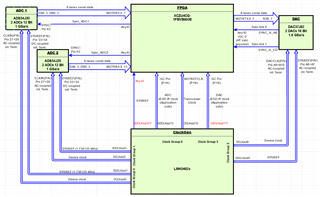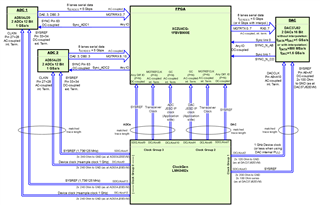Other Parts Discussed in Thread: DAC37J82, , LMK04828
Hi!
We have a new project where we want to connect two ADCs and a DAC via JESD204B with a Xilinx Ultrascale+ XCZU4CG.
I read several information about JESD204B already, but I have still some questions especially about connecting clocks from LMK0482x to FPGA.
Our plan so far:
- MPSoC XCZU4CG-1FBVB900E
- LMK0482x PLL / clock cleaner
- 2 x ADS54J20 devices (4 ADCs)
- ADC LMFS configuration 8224. So 8 lanes at 5 Gbps per ADS54J20 device (16 lanes in total).
- 1 x DAC37J82 (2 DACs)
- JESD204B subclass 1
My questions:
- Do we have to connect the "device clock" to MGTREFCLKxP/N or to FPGA clock pins (GC, QBC)?
- I read that SYSREF must be connected to FPGA clock pins. But to which clock pins? Do they have special requirements like GC or QBC clock pins at a HP bank or would HDGC clock pins on a HD bank be fine?
- Does SYNC need a general I/O on HP bank or would any pin on a HD bank be fine? Should it be located in the same bank as the SYSREF clock?
Best regards,



